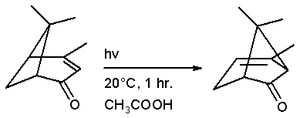Verbenone
| |||
| Names | |||
|---|---|---|---|
| IUPAC name
(1R)-cis-4,6,6-Trimethylbicyclo[3.1.1]hept-3-en-2-one | |||
| Other names
Verbenone 2-Pinen-4-one | |||
| Identifiers | |||
| 80-57-9 | |||
| ChEBI | CHEBI:9955 | ||
| Jmol-3D images | Image | ||
| |||
| UNII | 99S17893UW | ||
| Properties | |||
| Molecular formula |
C10H14O | ||
| Molar mass | 150.22 g·mol−1 | ||
| Density | 0.978 g/cm3 | ||
| Melting point | 6.5 °C (43.7 °F; 279.6 K) | ||
| Boiling point | 227 °C (441 °F; 500 K) | ||
| Except where noted otherwise, data is given for materials in their standard state (at 25 °C (77 °F), 100 kPa) | |||
| | |||
| Infobox references | |||
Verbenone is a natural organic compound classified as a terpene that is found naturally in a variety of plants. The chemical has a pleasant characteristic odor. Besides being a natural constituent of plants, it and its analogs are insect pheromones. In particular, verbenone when formulated in a long-lasting matrix has an important role in the control of bark beetles such as the mountain pine beetle and the Southern pine bark beetle.
Chemistry
Verbenone is a terpene, to be specific a bicyclic ketone terpene. It is the primary constituent of the oil of Spanish verbena, hence its name; it is also found in the oil of rosemary. It is nearly insoluble in water, but miscible with most organic solvents.[1]
Verbenone can be readily prepared synthetically by the oxidation of the more common terpene α-pinene:[2]
Verbenone can then be converted into chrysanthenone through a photochemical rearrangement reaction:[3]
Use for insect control
The southern pine beetle (Dendroctonus frontalis), a bark beetle, is a major threat to pine trees in the southeastern United States. Its reproductive cycle is controlled by varying ratios of certain natural chemicals, including verbenone. To reproduce, pine bark beetles aggregate in large numbers in their host pine trees. At the beginning of an attack, various chemicals produced by infested trees and by the beetles attract additional beetles of the same species. When the numbers of adults and larvae approach the maximum that the tree can support, antiaggregation signal chemicals, i.e., verbenone, are produced, reducing the likelihood that additional beetles will land and attack the tree. Forest managers frequently try to control infestations of the Southern pine bark beetle by cutting down and sometimes burning infested trees and nearby healthy trees. They then place verbenone formulations on nearby susceptible healthy trees to repel and confuse the beetles.[4]
Verbenone is also used to manage mountain pine beetle (Dendroctonus ponderosae) infestations.[5] Verbenone is the principal antiaggregation pheromone of the mountain pine beetle, Dendroctonus ponderosae Hopkins, a notable forest insect capable of causing extensive levels of tree mortality in western North America. Although several formulations of verbenone have been registered with the U.S. Environmental Protection Agency [6] for tree protection, failures in efficacy are rather common. Unlike previous formulations, a new formulation of (–)-verbenone registered as SPLAT® Verb [7] (ISCA Technologies Inc., Riverside, CA) was found to be extremely efficient in protecting individual lodgepole pine, Pinus contorta Dougl. ex Loud., and small stands of P. contorta from mortality attributed to D. ponderosae. SPLAT® Verb applications resulted in complete individual P. contorta tree protection while 93.3% mortality occurred in the untreated controls; furthermore significantly fewer P. contorta were killed by D. ponderosae within 0.041-ha circular plots (11-m radius) surrounding P. contorta treated with SPLAT® Verb compared to the untreated control. [8]
Other uses
Because of its pleasant aroma, verbenone (or essential oils high in verbenone content) are used in perfumery, aromatherapy, herbal teas, spices, and herbal remedies. The L-isomer is used as a cough suppressant under the name levoverbenone. Verbenone may also have antimicrobial properties.[9]
References
- ↑ Merck Index, 11th Edition, 9862.
- ↑ Glidden, U.S. Patent 2,911,442 (1959).
- ↑ Erman, William F. (1967). "Photochemical transformations of unsaturated bicyclic ketones. Verbenone and its photodynamic products of ultraviolet irradiation". Journal of the American Chemical Society 89 (15): 3828. doi:10.1021/ja00991a026.
- ↑ U.S. Environmental Protection Agency Pesticide Fact Sheet #128986.
- ↑ Mafra-Neto, Agenor; de Lame, Frédérique M.; Fettig, Christopher J.; Perring, Thomas M.; Stelinski, Lukasz L.; Stoltman, Lyndsie L.; Mafra, Leandro E. J.; Borges, Rafael; Vargas, Roger I. (2013). "Manipulation of Insect Behavior with Specialized Pheromone and Lure Application Technology (SPLAT®)". In John Beck, Joel Coats, Stephen Duke, and Marja Koivunen. Natural Products for Pest Management 1141. American Chemical Society. pp. 31–58.
- ↑ U.S. Environmental Protection Agency Pesticide Fact Sheet #128986.
- ↑ SPLAT Verb Information Page http://www.iscatech.com/exec/SPLATVerbtest.html
- ↑ Mafra-Neto, Agenor; Fettig, Christopher J.; Munson, A.S.; Stelinski, Lukasz L. (2014). "The use of repellents formulated in Specialized Pheromone and Lure Application Technology (SPLAT®) for effective insect pest management.". In Debboun, M., S.P. Francis, and D.A. Strickman. Insect Repellents Handbook, Second Edition. Taylor & Francis, London. pp. 291–314.
- ↑ Santoyo, S; Cavero, S; Jaime, L; Ibañez, E; Señoráns, FJ; Reglero, G (2005). "Chemical composition and antimicrobial activity of Rosmarinus officinalis L. Essential oil obtained via supercritical fluid extraction". Journal of food protection 68 (4): 790–5. PMID 15830672.
External links
- U.S. Environmental Protection Agency Fact sheet for verbenone.
n



